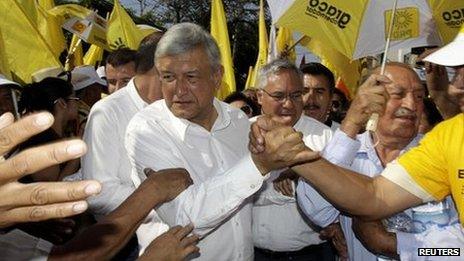Mexico election: Andres Manuel Lopez Obrador
- Published

Six years ago Andres Manuel Lopez Obrador lost the Mexican presidential election by less than one percentage point to Felipe Calderon.
For months, Mr Lopez Obrador refused to recognise a result he saw as fraudulent.
He brought his supporters out onto the streets of central Mexico City and railed against the rich and powerful business elite.
The faithful stood by him and in November 2006 he held his inauguration as the "legitimate president", but his appeal waned among the wider electorate.
The upheaval of the disputed election result also strained ties between Mr Lopez Obrador, 58, and his Party of the Democratic Revolution (PRD).
But today relations between them have been patched up.
He is running as the candidate of the Progressive Movement coalition that brings together the PRD and two other parties, the Labour Party (PT) and the Citizens' Movement.
And he has adopted a more moderate tone, apologising for the disruption the protests of 2006 caused.
Attacks on 'oligopolies'
His comments have become more business-friendly, too, and he has often stressed his model is Brazil's economic growth under President Luiz Inacio Lula da Silva.
But his attacks on corruption and the private sector "oligopolies" have continued.
Mr Lopez Obrador is widely known by his initials as Amlo or "Peje" after a fish in his home state of Tabasco.
His calls for a "loving republic" have even earned him a new nickname among some pundits as "Amlove."
As mayor of the capital, Mexico City, from 2000 to 2005, he won respect for a gruelling work schedule.
He embarked on a series of public works and established social-welfare programmes targeting the poor and disadvantaged.
Despite not holding office for several years, Mr Lopez Obrador has maintained a high political profile, holding rallies and meetings across the country.
- Published30 March 2012